![]()
![]()
![]()
Use LEFT and RIGHT arrow keys to navigate between flashcards;
Use UP and DOWN arrow keys to flip the card;
H to show hint;
A reads text to speech;
321 Cards in this Set
- Front
- Back
- 3rd side (hint)
|
Sternocleidomastoid action ***
(1413 Ex3) |
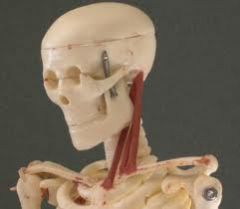
|
unilaterally
- ipsilateral flexion of cervical spine - contralateral rotation of head bilaterally - flexion of cervical spine - elevation of sternum/rib cage in forced inspiration |
|
|
Sternocleidomastoid innervation ***
(1413 Ex3) |
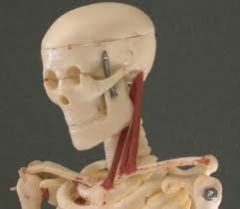
|
C1-C3
|
|
|
Sternocleidomastoid origin ***
(2409) (1413 Ex3) |
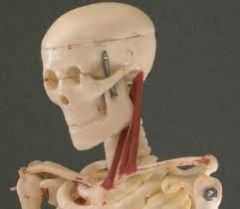
|
- sternal (medial) head: top of manubrium (ventral surface)
- clavicular (lateral) head: superior and anterior surface of medial 1/3 of clavicle |
|
|
Sternocleidomastoid insertion ***
(2409) (1413 Ex3) |
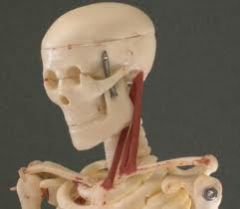
|
- lateral surface of mastoid process of temporal bone
- lateral half of superior nuchal line of occiput |
|
|
Trapezius (upper) action ***
(1413 Ex2) |
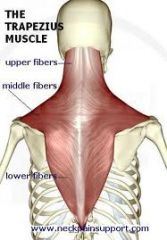
|
all trapezius muscles
- stabilize scapula during movements of the arm unilaterally - contralateral rotation of head - ipsilateral flexion of head and neck - elevation of scapula and shoulder ("shrugging") (with levator scapulae) - upward rotation of scapula (glenoid faces up/inferior angle moves laterally and forward) (with lower trapezius and serratus anterior) bilaterally - cervical extension - capital extension |
|
|
Trapezius (upper) innervation ***
(1413 Ex2) |
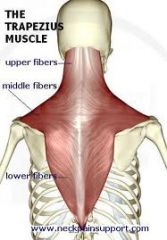
|
- spinal portion of cranial nerve XI (accessory)
- ventral ramus C2, C3, C4 while the accessory nerve provides the major motor supply to the trapezius, there also is some supply from the cervical plexus (C3-C4), and this may be the primary supply of the lower fibers with contributions from the accessory nerve |
|
|
Trapezius (upper) origin ***
(1413 Ex2) |
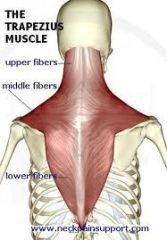
|
- external occipital protuberance and medial 1/3 of superior nuchal line
- ligamentum nuchae - spinous process of C7 vertebra |
|
|
Trapezius (upper) insertion ***
(1413 Ex2) |
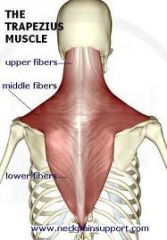
|
lateral 1/3 of posterior surface of clavicle
|
|
|
Trapezius (middle) action ***
(1413 Ex2) |
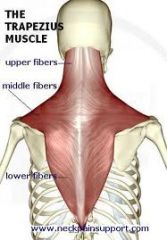
|
all trapezius muscles
- stabilize scapula during movements of the arm - scapular adduction (retraction) (with rhomboids) |
|
|
Trapezius (middle) innervation ***
(1413 Ex2) |
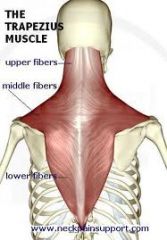
|
- spinal portion of cranial nerve XI (accessory)
- ventral ramus C2, C3, C4 while the accessory nerve provides the major motor supply to the trapezius, there also is some supply from the cervical plexus (C3-C4), and this may be the primary supply of the lower fibers with contributions from the accessory nerve |
|
|
Trapezius (middle) origin ***
(2409) (1413 Ex2) |
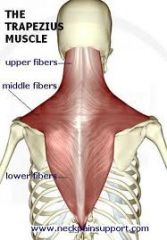
|
spinous processes of T1-T5 vertebrae
|
|
|
Trapezius (middle) insertion ***
(2409) (1413 Ex2) |

|
scapula (medial margin of acromion, spine of scapula, and crest of its superior lip)
|
|
|
Trapezius (lower) action ***
(1413 Ex2) |
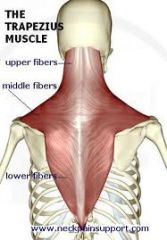
|
all trapezius muscles
- stabilize scapula during movements of the arm - scapular adduction - scapular depression - upward rotation of scapula (glenoid faces up) (with upper fibers and serratus anterior) |
|
|
Trapezius (lower) innervation ***
(1413 Ex2) |
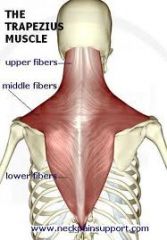
|
spinal portion of cranial nerve XI (accessory) (mainly upper and middle)
and ventral ramus C2, C3, C4 while the accessory nerve provides the major motor supply to the trapezius, there also is some supply from the cervical plexus (C3-C4), and this may be the primary supply of the lower fibers with contributions from the accessory nerve |
|
|
Trapezius (lower) origin ***
(2409) (1413 Ex2) |
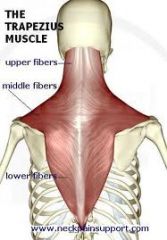
|
spinous processes of T6-T12 vertebrae
|
|
|
Trapezius (lower) insertion ***
(2409) (1413 Ex2) |
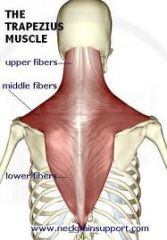
|
scapular spine
|
|
|
Rhomboid (major) action ***
(1413 Ex2) |

|
- adduct scapula
- elevate scapula - downwardly rotate scapula (glenoid faces down) |
|
|
Rhomboid (major) innervation ***
(1413 Ex2) |
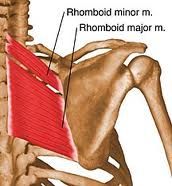
|
dorsal scapular C4, C5
|
|
|
Rhomboid (major) origin ***
(2409) (1413 Ex2) |
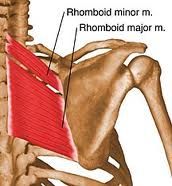
|
spinous processes of T2-T5
|
|
|
Rhomboid (major) insertion ***
(2409) (1413 Ex2) |

|
medial border of the scapula between the root of the spine and inferior angle
|
|
|
Rhomboid (minor) action ***
(1413 Ex2) |
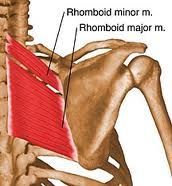
|
- adduct scapula
- elevate scapula - downwardly rotate scapula (glenoid faces down) |
|
|
Rhomboid (minor) innervation ***
(1413 Ex2) |
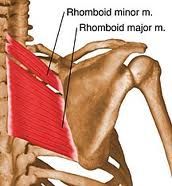
|
dorsal scapular C4, C5
|
|
|
Rhomboid (minor) origin ***
(2409) (1413 Ex2) |
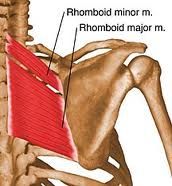
|
spinous processes of C7-T1
|
|
|
Rhomboid (minor) insertion ***
(2409 (1413 Ex2) |
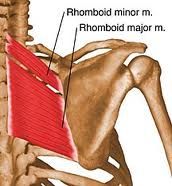
|
upper portion of medial border of the scapula across from root of spine
|
|
|
Deltoid (anterior) action ***
(1413 Ex2) |

|
all deltoid fibers abduct the shoulder (primarily the acromial middle fibers, while the anterior and posterior stabilize)
- flex shoulder - internally rotate shoulder - horizontally adduct shoulder |
|
|
Deltoid (anterior) innervation ***
(1413 Ex2) |
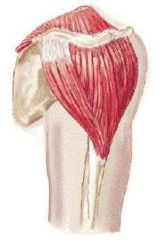
|
axillary C5-C6
|
|
|
Deltoid (anterior) origin ***
(2409) (1413 Ex2) |
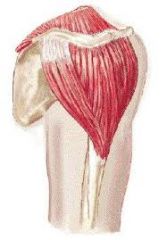
|
clavicle (anterior border and superior surface of lateral 1/3)
|
|
|
Deltoid (anterior) insertion ***
(2409) (1413 Ex2) |

|
deltoid tuberosity of humerus
|
|
|
Deltoid (middle) action ***
(1413 Ex2) |

|
all deltoid fibers abduct the shoulder (primarily the acromial middle fibers, while the anterior and posterior stabilize)
|
|
|
Deltoid (middle) innervation ***
(1413 Ex2) |
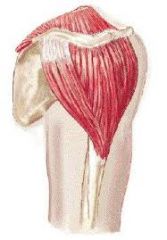
|
axillary C5-C6
|
|
|
Deltoid (middle) origin ***
(2409) (1413 Ex2) |
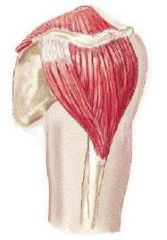
|
scapula (acromion, lateral margin, and superior surface)
|
|
|
Deltoid (middle) insertion ***
(2409) (1413 Ex2) |

|
deltoid tuberosity of humerus
|
|
|
Deltoid (posterior) action ***
(1413 Ex2) |
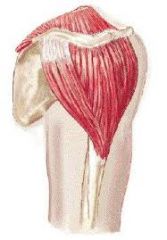
|
all deltoid fibers abduct the shoulder (primarily the acromial middle fibers, while the anterior and posterior stabilize)
- extend shoulder - externally rotate shoulder - horizontally abduct shoulder |
|
|
Deltoid (posterior) innervation ***
(1413 Ex2) |
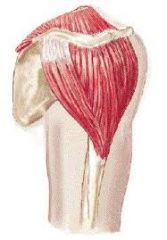
|
axillary C5-C6
|
|
|
Deltoid (posterior) origin ***
(1413 Ex2) |
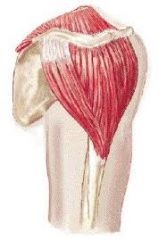
|
scapula (spine on lower lip of posterior border)
|
|
|
Deltoid (posterior) insertion ***
(1413 Ex2) |
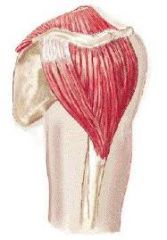
|
deltoid tuberosity of humerus
|
|
|
Pectoralis major action ***
(1413 Ex2) |

|
all fibers
- adduct shoulder - internally rotate shoulder - assist to elevate thorax during forced inhalation (with the arm fixed) clavicular/upper fibers - flex shoulder - horizontally adduct shoulder sternocostal/lower fibers - extend the shoulder |
|
|
Pectoralis major innervation ***
(1413 Ex2) |

|
clavicular/upper fibers
- lateral pectoral C5, C6, C7 sternocostal/lower fibers - lateral and medial pectoral C6, C7, C8, T1 |
|
|
Pectoralis major origin ***
(2409) (1413 Ex2) |
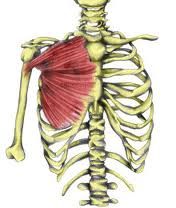
|
clavicular/upper fibers
- medial half of anterior clavicle sternocostal/lower fibers - sternum and cartilage of ribs 1-6 |
|
|
Pectoralis major insertion ***
(2409) (1413 Ex2) |
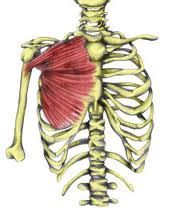
|
Crest of greater tubercle of humerus
(intertubercular sulcus, lateral border via a bilaminar tendon) |
|
|
Subscapularis action ***
(1413 Ex2) |
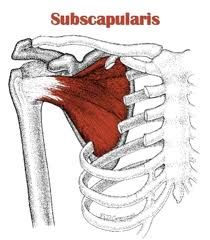
|
- internally rotate shoulder
- stabilize head of humerus in glenoid fossa |
|
|
Subscapularis innervation ***
(1413 Ex2) |
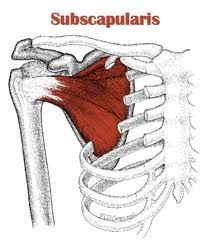
|
upper and lower subscapular C5, C6, C7
|
|
|
Subscapularis origin ***
(2409) (1413 Ex2) |
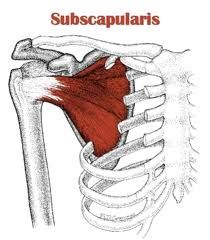
|
subscapular fossa of the scapula
|
|
|
Subscapularis insertion ***
(2409) (1413 Ex2) |
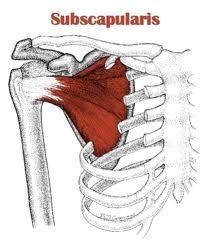
|
lesser tubercle of humerus
|
|
|
Infraspinatus action ***
(1413 Ex2) |
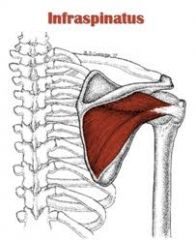
|
- externally rotate shoulder
- adduct shoulder - stabilize head of humerus in glenoid fossa |
|
|
Infraspinatus innervation ***
(1413 Ex2) |
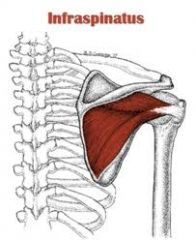
|
suprascapular C(4), C5, C6
|
|
|
Infraspinatus origin ***
(2409) (1413 Ex2) |
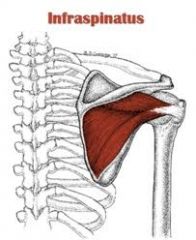
|
infraspinous fossa of the scapula
|
|
|
Infraspinatus insertion ***
(2409) (1413 Ex2) |
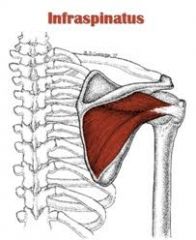
|
greater tubercle of humerus
|
|
|
Supraspinatus action ***
(1413 Ex2) |
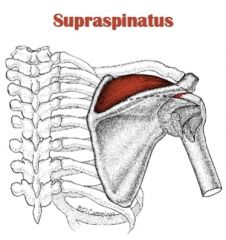
|
- abduct shoulder
- stabilize head of humerus in glenoid fossa |
|
|
Supraspinatus innervation ***
(1413 Ex2) |
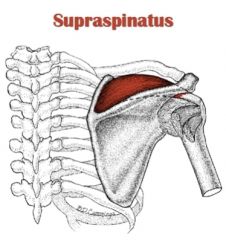
|
suprascapular C4, C5, C6
|
|
|
Supraspinatus origin ***
(2409) (1413 Ex2) |

|
supraspinous fossa of the scapula (medial 2/3)
|
|
|
Supraspinatus insertion ***
(2409) (1413 Ex2) |
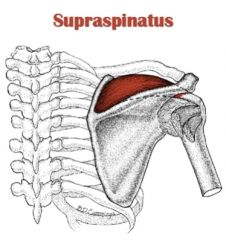
|
greater tubercle of the humerus
|
|
|
Serratus anterior action ***
(1413 Ex2) |
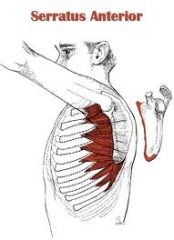
|
with origin fixed:
- abduct scapula - upwardly rotate scapula - depress scapula - hold medial border of scapula against rib cage with scapula fixed: - elevate thorax during forced inhalation |
|
|
Serratus anterior innervation ***
(1413 Ex2) |
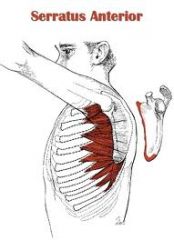
|
long thoracic C5, C6, C7, C8
|
|
|
Serratus anterior origin ***
(1413 Ex2) |
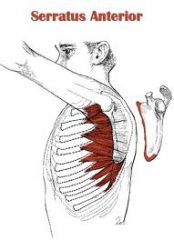
|
external surfaces of upper 8 or 9 ribs
|
|
|
Serratus anterior insertion ***
(1413 Ex2) |

|
anterior surface of medial border of scapula
|
|
|
Biceps brachii action ***
(1413 Ex2) |

|
- flex elbow
- supinate forearm - flex shoulder |
|
|
Biceps brachii innervation ***
(1413 Ex2) |

|
musculocutaneous C5, C6
|
|
|
Biceps brachii origin ***
(2409) (1413 Ex2) |
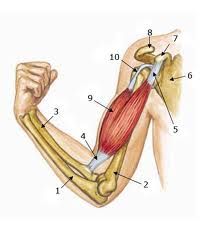
|
short head:
- coracoid process of scapula long head: - supraglenoid tubercle of scapula |
|
|
Biceps brachii insertion ***
(2409) (1413 Ex2) |

|
- tuberosity of the radius
- aponeurosis of biceps brachii |
|
|
Triceps brachii action ***
(1413 Ex2) |
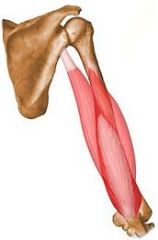
|
all heads:
- extend elbow long head: - extend shoulder - adduct shoulder |
|
|
Triceps brachii innervation ***
(1413 Ex2) |

|
radial C6, C7, C8, T1
|
|
|
Triceps brachii origin ***
(1413 Ex2) |
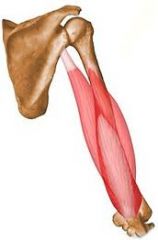
|
long head:
- infraglenoid tuberosity of the scapula lateral head: - posterior surface of proximal half of humerus medial head: - posterior surface of distal half of the humerus |
|
|
Triceps brachii insertion ***
(1413 Ex2) |
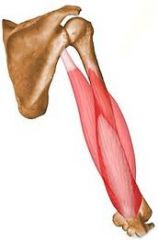
|
olecranon process of the ulna
|
|
|
Flexor carpi ulnaris action ***
(1413 Ex2) |
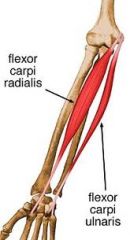
|
- flex wrist
- adduct wrist--ulnar deviation - assist to flex elbow |
|
|
Flexor carpi ulnaris innervation ***
(1413 Ex2) |
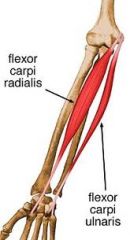
|
ulnar C7, C8, T1
|
|
|
Flexor carpi ulnaris origin ***
(1413 Ex2) |
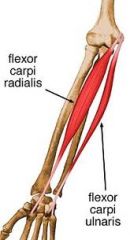
|
humeral head:
- common flexor tendon from medial epicondyle of humerus ulnar head: - posterior surface of proximal 2/3 of ulna |
|
|
Flexor carpi ulnaris insertion ***
(1413 Ex2) |
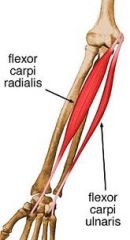
|
- pisiform
- hook of the hamate - base of 5th metacarpal |
|
|
Flexor carpi radialis action ***
(1413 Ex2) |
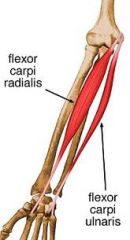
|
- flex wrist
- abduct wrist--radial deviation - may assist to flex elbow and pronate forearm |
|
|
Flexor carpi radialis innervation ***
(1413 Ex2) |
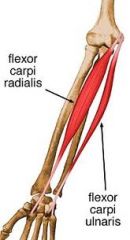
|
median C6, C7, C8
|
|
|
Flexor carpi radialis origin ***
(1413 Ex2) |
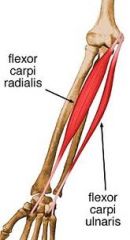
|
common flexor tendon from medial epicondyle of humerus
|
|
|
Flexor carpi radialis insertion ***
(1413 Ex2) |
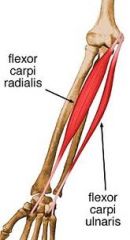
|
bases of 2nd and 3rd metacarpals (palmar surfaces)
|
|
|
Extensor carpi radialis longus action ***
(1413 Ex2) |

|
- extend wrist
- abduct wrist--radial deviation - assist to flex elbow |
|
|
Extensor carpi radialis longus innervation ***
(1413 Ex2) |

|
radial C5, C6, C7, C8
|
|
|
Extensor carpi radialis longus origin ***
(2409) (1413 Ex2) |

|
distal one-third of the lateral supracondylar ridge of the humerus
|
|
|
Extensor carpi radialis longus insertion ***
(2409) (1413 Ex2) |

|
base of second metacarpal
(dorsal surface of base on radial side) |
|
|
Extensor carpi ulnaris action ***
(1413 Ex2) |
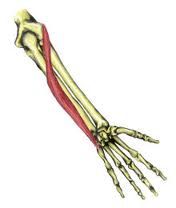
|
- extend wrist
- adduct wrist--ulnar deviation |
|
|
Extensor carpi ulnaris innervation ***
(1413 Ex2) |
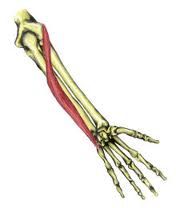
|
radial C6, C7, C8 (posterior interosseous branch)
|
|
|
Extensor carpi ulnaris origin ***
(2409) (1413 Ex2) |
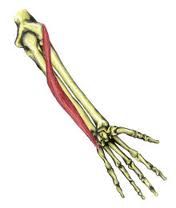
|
common extensor tendon from the lateral epicondyle of humerus
|
|
|
Extensor carpi ulnaris insertion ***
(2409) (1413 Ex2) |
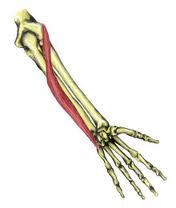
|
base of 5th metacarpal
(tubercle on underside of base) |
|
|
Flexor digitorum profundus action ***
(1413 Ex2) |
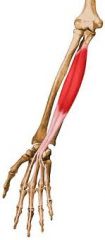
|
- flex 2nd through 5th fingers (primarily DIP, but assists MCP and PIP)
- assist to flex wrist |
|
|
Flexor digitorum profundus innervation ***
(1413 Ex2) |

|
2nd and 3rd fingers:
- median C7, C8, T1 4th and 5th fingers - ulnar C7, C8, T1 |
|
|
Flexor digitorum profundus origin ***
(1413 Ex2) |
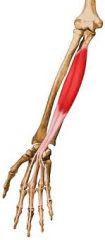
|
anterior and medial surfaces of proximal 3/4 of ulna
|
|
|
Flexor digitorum profundus insertion ***
(1413 Ex2) |
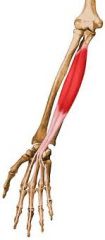
|
bases of distal phalanges on palmar surface of 2nd through 5th fingers
|
|
|
Quadratus lumborum action ***
(1413 Ex3) |
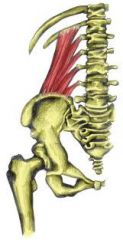
|
unilaterally
- laterally tilt (elevate) pelvis (hip hike) - ipsilaterally flex vertebral column - assist to extend vertebral column bilaterally - fix the last rib during forced inhalation and exhalation |
|
|
Quadratus lumborum innervation ***
(1413 Ex3) |
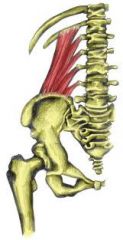
|
lumbar plexus T12, L1, L2, L3
|
|
|
Quadratus lumborum origin ***
(2409) (1413 Ex3) |

|
posterior iliac crest/inner lip
|
|
|
Quadratus lumborum insertion ***
(2409) (1413 Ex3) |
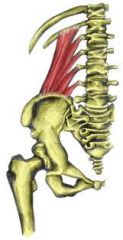
|
- 12th (last) rib
- transverse processes of 1st through 4th lumbar vertebrae |
|
|
Sartorius action ***
(1413 Ex3) |
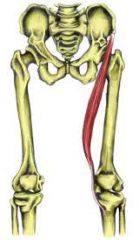
|
- flex hip
- externally rotate hip - abduct hip - flex knee - internally rotate flexed knee |
|
|
Sartorius innervation ***
(1413 Ex3) |
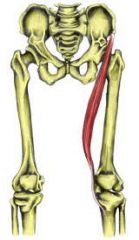
|
femoral L2, L3, (L4)
|
|
|
Sartorius origin ***
(2409) (1413 Ex3) |
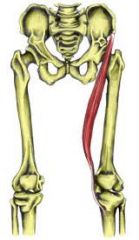
|
anterior superior iliac spine (ASIS)
|
|
|
Sartorius insertion ***
(2409) (1413 Ex3) |
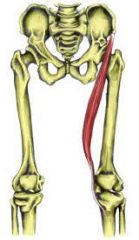
|
proximal, medial shaft of the tibia at the pes anserinus tendon (along with gracilis and semitendinosus)
|
|
|
Psoas major action ***
(1413 Ex3) |

|
with origin fixed
- flex hip* - externally rotate hip with insertion fixed - flex trunk toward thigh (sit-up)* - tilt pelvis anteriorly unilaterally - assist to ipsilaterally flex lumbar spine *in conjunction with iliacus |
|
|
Psoas major innervation ***
(1413 Ex3) |
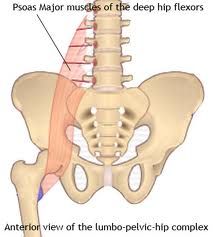
|
lumbar plexus L1, L2, L3, L4
|
|
|
Psoas major origin ***
(1413 Ex3) |
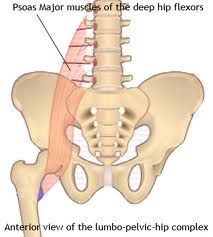
|
bodies and transverse processes of lumbar vertebrae (L1 - L5)
|
|
|
Psoas major insertion ***
(1413 Ex3) |
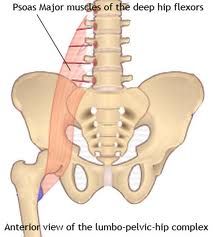
|
lesser trochanter of femur
|
|
|
Gluteus maximus action ***
(1413 Ex3) |
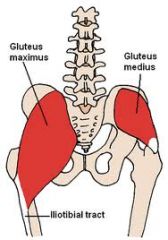
|
all fibers
- extend hip - externally rotate hip - abduct hip - lower fibers - adduct hip |
|
|
Gluteus maximus innervation ***
(1413 Ex3) |

|
Inferior gluteal L5, S1, S2
|
|
|
Gluteus maximus origin ***
(2409) (1413 Ex3) |

|
- coccyx
- dorsal edge of sacrum - posterior iliac crest - sacrotuberous and sacroiliac ligament |
|
|
Gluteus maximus insertion ***
(2409) (1413 Ex3) |
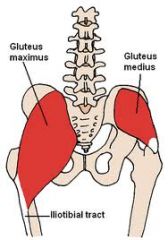
|
- iliotibial tract of TFL (upper fibers)
- gluteal tuberosity of femur (lower fibers) |
|
|
Gluteus medius action ***
(1413 Ex3) |
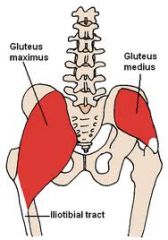
|
all fibers
- abduct hip anterior fibers - flex hip - internally rotate hip posterior fibers - extend hip - externally rotate hip |
|
|
Gluteus medius innervation ***
(1413 Ex3) |
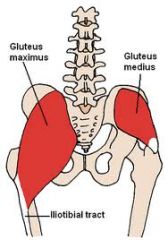
|
superior gluteal L4, L5, S1
|
|
|
Gluteus medius origin ***
(2409) (1413 Ex3) |
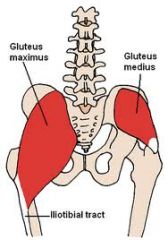
|
gluteal surface of ilium between the posterior and anterior gluteal lines just below the iliac crest
|
|
|
Gluteus medius insertion ***
(2409) (1413 Ex3) |
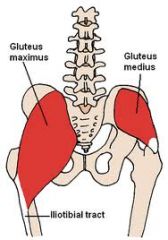
|
lateral aspect of the greater trochanter of the femur
|
|
|
Piriformis action ***
(1413 Ex3) |
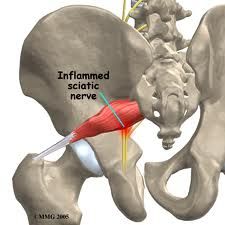
|
- externally rotate hip
- abduct hip when hip is flexed |
|
|
Piriformis innervation ***
(1413 Ex3) |
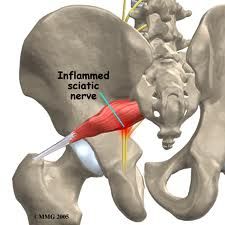
|
sacral plexus L5, S1, S2
|
|
|
Piriformis origin ***
(2409) (1413 Ex3) |

|
anterior surface of sacrum
|
|
|
Piriformis insertion ***
(2409) (1413 Ex3) |
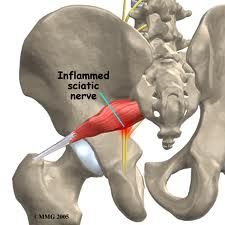
|
superior aspect of greater trochanter of the femur
|
|
|
Tensor fasciae latae action ***
(1413 Ex3) |
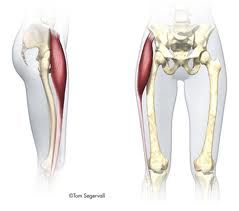
|
- flex hip
- internally rotate hip - abduct hip |
|
|
Tensor fasciae latae innervation ***
(1413 Ex3) |
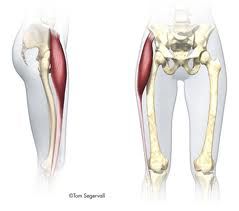
|
superior gluteal L4, L5, S1
|
|
|
Tensor fasciae latae origin ***
(2409) (1413 Ex3) |
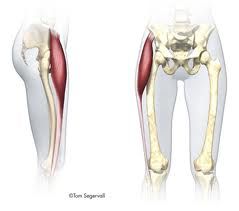
|
iliac crest posterior to the anterior superior iliac spine (ASIS)
|
|
|
Tensor fasciae latae insertion ***
(2409) (1413 Ex3) |
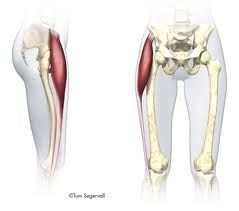
|
iliotibial tract, which connects to the femur
|
|
|
Semitendinosus action ***
(1413 Ex3) |
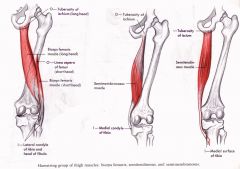
|
- extend hip
- flex knee - internally rotate flexed knee - assist to internally rotate hip - tilt pelvis posteriorly |
|
|
Semitendinosus innervation ***
(1413 Ex3) |
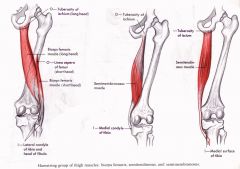
|
sciatic (tibial branch) L4, L5, S1, S2
|
|
|
Semitendinosus origin ***
(2409) (1413 Ex3) |

|
ischial tuberosity (inferior medial aspect)
|
|
|
Semitendinosus insertion ***
(2409) (1413 Ex3) |
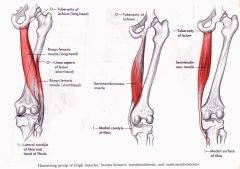
|
proximal, medial shaft of tibia at pes anserinus tendon (along with sartorius and gracilis)
|
|
|
Semimembranosus action ***
(1413 Ex3) |
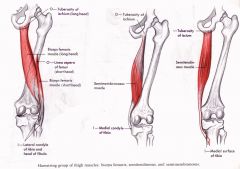
|
- extend hip
- flex knee - internally rotate flexed knee - assist to internally rotate hip - tilt pelvis posteriorly |
|
|
Semimembranosus innervation ***
(1413 Ex3) |
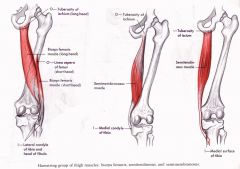
|
sciatic (tibial branch) L4, L5, S1, S2
|
|
|
Semimembranosus origin ***
(1413 Ex3) |
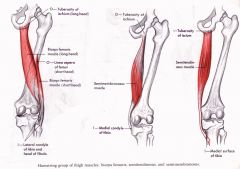
|
ischial tuberosity (superior and lateral facets)
|
|
|
Semimembranosus insertion ***
(1413 Ex3) |
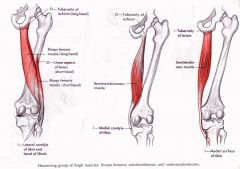
|
posterior aspect of medial condyle of tibia
|
|
|
Biceps femoris action ***
(1413 Ex3) |
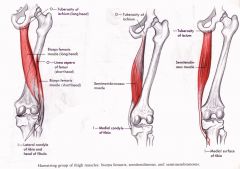
|
- flex knee (short head is a pure knee flexor)
- externally rotate flexed knee long head - extend hip - assist to externally rotate hip - tilt pelvis posteriorly |
|
|
Biceps femoris innervation ***
(1413 Ex3) |
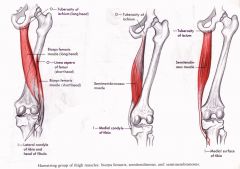
|
long head
- sciatic (tibial branch) L5, S1, S2, S3 short head - sciatic (peroneal branch) L5, S1, S2 |
|
|
Biceps femoris origin ***
(2409) (1413 Ex3) |
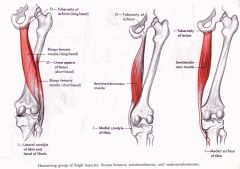
|
long head
- ischial tuberosity (inferior and medial aspects, common with semitendinosus) short head - lateral lip of linea aspera of femur |
|
|
Biceps femoris insertion ***
(2409) (1413 Ex3) |
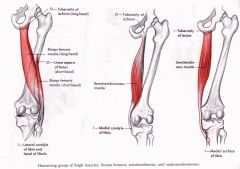
|
head of fibula
|
|
|
Rectus femoris action ***
(1413 Ex3) |
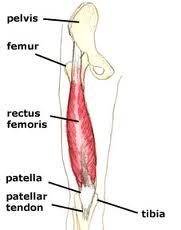
|
- extend knee
- flex hip |
|
|
Rectus femoris innervation ***
(1413 Ex3) |
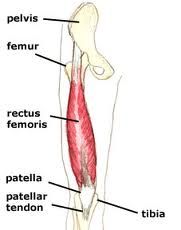
|
femoral L2, L3, L4
|
|
|
Rectus femoris origin ***
(1413 Ex3) |

|
anterior inferior iliac spine (AIIS)
|
|
|
Rectus femoris insertion ***
(1413 Ex3) |

|
tibial tuberosity (via patella and patellar ligament)
|
|
|
Gastrocnemius action ***
(1413 Ex3) |

|
- flex knee
- plantar flex ankle |
|
|
Gastrocnemius innervation ***
(1413 Ex3) |
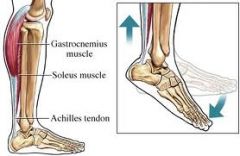
|
tibial S1, S2
|
|
|
Gastrocnemius origin ***
(1413 Ex3) |
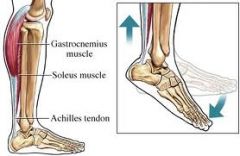
|
condyles of femur (posterior surfaces)
|
|
|
Gastrocnemius insertion ***
(1413 Ex3) |

|
calcaneus (via calcaneal/Achilles tendon)
|
|
|
Tibialis anterior action ***
(1413 Ex3) |

|
- invert foot
- dorsiflex ankle |
|
|
Tibialis anterior innervation ***
(1413 Ex3) |
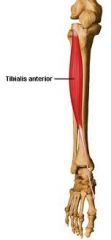
|
deep peroneal L4, L5, S1
|
|
|
Tibialis anterior origin ***
(2409) (1413 Ex3) |
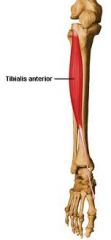
|
- lateral condyle of tibia
- proximal, lateral surface of tibia and interosseous membrane |
|
|
Tibialis anterior insertion ***
(2409) (1413 Ex3) |
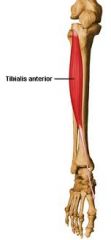
|
- medial cuneiform and
- base of first metatarsal |
|
|
Peroneus (Tertius) longus action ***
(1413 Ex3) |

|
- evert foot
- assist to plantar flex ankle |
|
|
Peroneus (Tertius) longus innervation ***
(1413 Ex3) |
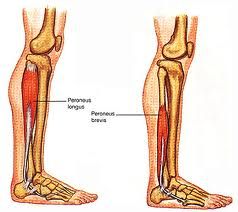
|
superficial peroneal L4, L5, S1
|
|
|
Peroneus (Tertius) longus origin ***
(2409) (1413 Ex3) |
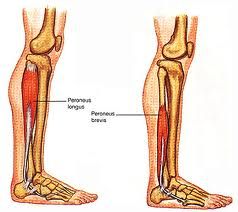
|
- head of fibula and
- proximal 2/3 of lateral fibula |
|
|
Peroneus (Tertius) longus insertion ***
(2409) (1413 Ex3) |
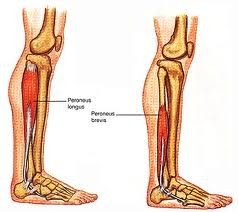
|
- base of first metatarsal and
- medial cuneiform |
|
|
Prime movers for scapular elevation
(2409) (1413 Ex2) |
- trapezius (upper fibers)
- levator scapulae (- rhomboids) |
|
|
|
Prime movers for scapular adduction (retraction) and downward rotation
(2409) |
- rhomboid major
- rhomboid minor |
|
|
|
Prime movers for scapular adduction (retraction)
(2409) (1413 Ex2) |
- trapezius (middle fibers)
- rhomboid major |
|
|
|
Prime movers for finger abduction
(2409) |
- dorsal interossei
- abductor digiti minimi |
|
|
|
Prime movers for finger adduction
(2409) |
- palmar interossei
|
|
|
|
Prime movers for thumb MCP and IP extension
(2409) |
- extensor pollicis brevis
- extensor pollicis longus |
|
|
|
Prime movers for thumb abduction
(2409) |
- abductor pollicis longus
- abductor pollicis brevis |
|
|
|
Prime movers for thumb adduction
(2409) |
- adductor pollicis (oblique and transverse heads)
|
|
|
|
Prime movers for trunk rotation
(2409) |
- external obliques (obliquus externus abdominis)
- internal obliques (obliquus internus abdominis) |
|
|
|
Prime movers for scapular abduction (protraction) and upward rotation
(1413 Ex2) |
- serratus anterior
|
|
|
|
Prime movers for scapular depression and adduction (retraction)
|
- trapezius (middle and lower fibers)
|
|
|
|
Prime movers for shoulder flexion to 90 degrees
(GH joint flexion) (1413 Ex2) |
- anterior deltoid
- coracobrachialis (- biceps brachii) (- pectoralis major, clavicular head) |
|
|
|
Prime movers for shoulder extension
(GH joint extension) (1413 Ex2) |
- latissimus dorsi
- teres major - posterior deltoid (- pectoralis major) (- long head of triceps) |
|
|
|
Prime movers for shoulder abduction to 90 degrees
(GH joint abduction) (1413 Ex2) |
- middle deltoid
- supraspinatus (- anterior deltoid) |
|
|
|
Prime movers for shoulder external rotation
(GH joint external rotation) (1413 Ex2) |
- infraspinatus
- teres minor (- posterior deltoid) |
|
|
|
Prime movers for shoulder internal rotation
(GH joint internal rotation) (1413 Ex2) |
- subscapularis
- pectoralis major - latissimus dorsi - teres major (- anterior deltoid) |
|
|
|
Prime movers for elbow flexion
(1413 Ex2) |
- biceps brachii
- brachialis - brachioradialis (- pronator teres) |
|
|
|
Prime movers for elbow extension
(1413 Ex2) |
- triceps brachii (all three heads)
(- anconeus) |
|
|
|
Prime movers for forearm supination
(1413 Ex2) |
- supinator
- biceps brachii (- extensor pollicis longus) (- extensor indicis) |
|
|
|
Prime movers for forearm pronation
(1413 Ex2) |
- pronator teres
- pronator quadratus (- flexor carpi radialis) (- palmaris longus) |
|
|
|
Prime movers for wrist flexion
(1413 Ex2) |
- flexor carpi radialis
- flexor carpi ulnaris (- palmaris longus) (- flexor pollicis longus) (- flexor digitorum superficialis) (- flexor digitorum profundus) |
|
|
|
Prime movers for wrist extension
(1413 Ex2) |
- extensor carpi radialis longus
- extensor carpi radialis brevis - extensor carpi ulnaris (- extensor pollicis longus) (- extensor indicis) (- extensor digitorum) (- extensor digiti minimi) |
|
|
|
Prime movers for finger flexion of MCP joints
|
- lumbricales
- dorsal interossei - palmar interossei |
|
|
|
Prime movers for finger flexion of PIP and DIP joints
|
- flexor digitorum superficialis
- flexor digitorum profundus |
|
|
|
Prime movers for finger extension of MCP joints
|
- extensor digitorum
- extensor indicis - extensor digiti minimi |
|
|
|
Prime movers for hip flexion
(2409) |
- psoas major
- iliacus |
|
|
|
Prime movers for hip flexion, abduction, and external rotation with knee flexion
(2409) |
- sartorius
|
|
|
|
Prime movers for hip extension
(2409) |
- gluteus maximus
- semitendinosus - semimembranosus - biceps femoris (long head) |
|
|
|
Prime movers for hip abduction
(2409) |
- gluteus medius
- gluteus minimus |
|
|
|
Prime movers for hip abduction from flexed position
(2409) |
- tensor fasciae latae
|
|
|
|
Prime movers for hip adduction
(2409) |
- adductor magnus
- adductor brevis - adductor longus - pectineus - gracilis |
|
|
|
Prime movers for hip external rotation
(2409) |
- obturator internus/externus
- gemellus superior/inferior - piriformis - quadratus femoris - gluteus maximus (posterior) |
|
|
|
Prime movers for hip internal rotation
(2409) |
- gluteus minimus (anterior)
- gluteus medius (anterior) - tensor fasciae latae |
|
|
|
Prime movers for knee flexion
(2409) |
- biceps femoris (long/short heads)
- semitendinosus - semimembranosus |
|
|
|
Prime movers for knee extension
(2409) |
- rectus femoris
- vastus lateralis - vastus intermedius - vastus medialis longus/oblique |
|
|
|
Prime movers for ankle plantar flexion
(2409) |
- gastrocnemius
- soleus |
|
|
|
Prime movers for foot dorsiflexion and inversion
(2409) |
- tibialis anterior
|
|
|
|
Prime movers for foot inversion
(2409) |
- tibialis posterior
|
|
|
|
Prime movers for foot eversion with plantar flexion
(2409) |
- peroneus longus
- peroneus brevis |
|
|
|
Muscles innervated by Cranial Nerve XI - Accessory
(1413 Ex2) |
- SCM
- upper trapezius - middle trapezius - lower trapezius (also ventral ramus) |
|
|
|
Muscles innervated by axillary nerve
(1413 Ex2) |
- anterior deltoid
- middle deltoid - posterior deltoid - teres minor |
|
|
|
Muscles innervated by thoracodorsal nerve
(1413 Ex2) |
latissimus dorsi
|
|
|
|
Muscles innervated by dorsal scapular nerve
(1413 Ex2) |
- rhomboid major
- rhomboid minor - levator scapula (also cervical) |
|
|
|
Muscles innervated by cervical nerves
(1413 Ex2) |
- sternocleidomastoid
- longus capitis - longus colli - levator scapula (also dorsal scapular) - anterior scalene - middle scalene - posterior scalene |
|
|
|
Muscles innervated by ventral ramus
(1413 Ex2) |
- upper trapezius
- middle trapezius - lower trapezius (also Cranial Nerve XI - Accessory) - rectus abdominis - external obliques - internal obliques - transverse abdominis |
|
|
|
Muscles innervated by upper subscapular nerve
(1413 Ex2) |
subscapularis
(also lower subscapular) |
|
|
|
Muscles innervated by lower subscapular nerve
(1413 Ex2) |
- subscapularis
- teres major |
|
|
|
Muscles innervated by suprascapular nerve
(1413 Ex2) |
- supraspinatus
- infraspinatus |
|
|
|
Muscles innervated by long thoracic nerve
(1413 Ex2) |
serratus anterior
|
|
|
|
Muscles innervated by subclavian nerve
(1413 Ex2) |
subclavius
|
|
|
|
Muscles innervated by lateral pectoral nerve
(1413 Ex2) |
- upper pectoralis major
- lower pectoralis major (with medial pectoral nerve) - pectoralis minor (with medial pectoral nerve--see pg 92) |
|
|
|
Muscles innervated by medial pectoral nerve
(1413 Ex2) |
- lower pectoralis major (with lateral pectoral nerve)
- pectoralis minor (with lateral pectoral nerve--see pg 92) |
|
|
|
Muscles innervated by musculocutaneous nerve
(1413 Ex2) |
- biceps brachii
- coracobrachialis - brachialis (with radial nerve) |
|
|
|
Muscles innervated by radial nerve
(1413 Ex2) |
- triceps brachii
- brachioradialis - brachialis (with musculocutaneous nerve) - supinator - anconeus - extensor carpi radialis longus - extensor carpi radialis brevis - extensor carpi ulnaris - extensor pollicis longus - extensor pollicis brevis - extensor indicis - extensor digitorum - abductor pollicis longus |
|
|
|
Muscles innervated by median nerve
(1413 Ex2) |
- pronator teres
- pronator quadratus - flexor carpi radialis - palmaris longus - flexor digitorum superficialis - flexor digitorum profundus (with ulnar nerve) - lumbricals (with ulnar nerve) - opponens pollicis - abductor pollicis brevis - flexor pollicis brevis (above 3 of the thenar eminence) - flexor pollicis longus |
|
|
|
Muscles innervated by ulnar nerve
(1413 Ex2) |
- flexor carpi ulnaris
- opponens digiti minimi - abductor digiti minimi - flexor digiti minimi brevis (above 3 of the hypothenar eminence) - palmar interossei - dorsal interossei - lumbricals (with median nerve) - flexor digitorum profundus (with median nerve) - flexor pollicis brevis (with median nerve) - adductor pollicis |
|
|
|
Levator scapulae
- action - innervation - origin - insertion (1413 Ex2) |
A
bilaterally - extend head and neck unilaterally - elevate scapula - downwardly rotate scapula - laterally flex head and neck - rotate head and neck to same side N - cervical 3, 4 - dorsal scapular C4, C5 O - transverse processes of C1-C4 I - medial border of scapula, between superior angle and superior portion of spine of scapula |
|
|
|
Pectoralis minor
- action - innervation - origin - insertion (1413 Ex2) |
A
- depress scapula - protract (abduct) scapula - downwardly rotate scapula with scapula fixed - assist to elevate thorax during forced inhalation N - medial pectoral, with fibers from a communicating branch of the lateral pectoral C(6), C7, C8, T1 O - ribs 3-5 I - medial surface of coracoid process of scapula |
|
|
|
Subclavius
- action - innervation - origin - insertion (1413 Ex2) |
A
- depress clavicle and draw it anteriorly - elevate first rib to assist inhalation - stabilize sternoclavicular joint N - subclavian C5, C6 O - first rib and cartilage I - inferior surface of middle 1/3 of clavicle |
|
|
|
Teres minor
- action - innervation - origin - insertion (1413 Ex2) |
A
- laterally rotate shoulder - adduct shoulder - stabilize head of humerus in glenoid fossa N - axillary C5, C6 O - upper 2/3 of lateral border of scapula I - greater tubercle of humerus |
|
|
|
Latissimus dorsi
- action - innervation - origin - insertion (1413 Ex2) |
A - extend, adduct, and medially rotate shoulder (GH joint)
N - thoracodorsal C6, C7, C8 O - inferior angle of scapula, spinous processes of last 6 thoracic vertebrae, last 3-4 ribs, thoracolumbar aponeurosis and posterior iliac crest I - intertubercular groove of the humerus |
|
|
|
Teres major
- action - innervation - origin - insertion (1413 Ex2) |
A
- extend shoulder - adduct shoulder - internally rotate shoulder (same motions as latissimus dorsi; lat's "little helper") N - lower subscapular C5, C6, C7 O - inferior angle and lower 1/3 of lateral border of scapula I - crest of the lesser tubercle of humerus |
|
|
|
Coracobrachialis
- action - innervation - origin - insertion (1413 Ex2) |
A
- flex the shoulder - adduct the shoulder N - musculocutaneous C6, C7 O - coracoid process of scapula I - medial surface of mid-humeral shaft |
|
|
|
Brachialis
- action - innervation - origin - insertion (1413 Ex2) |
A - flex the elbow
N - musculocutaneous, small branch from radial C5, C6 O - distal half of anterior surface of humerus I - tuberosity and coronoid process of ulna |
|
|
|
Brachioradialis
- action - innervation - origin - insertion (1413 Ex2) |
A
- flex the elbow - assist to pronate and supinate forearm when these movements are resisted N - radial C5, C6 O - proximal 2/3 of lateral supracondylar ridge of humerus I - styloid process of radius |
|
|
|
Extensor digitorum
- action - innervation - origin - insertion (1413 Ex2) |
A
- extend 2nd - 5th fingers (MCP and IP joints) - assist to extend wrist N - radial C6, C7, C8 O - common extensor tendon from the lateral epicondyle of humerus I - bases of middle and distal phalanges of 2nd - 5th fingers |
|
|
|
Anconeus
- action - innervation - origin - insertion (1413 Ex2) |
A - extend the elbow
N - radial C7, C8 O - posterior aspect of lateral epicondyle of the humerus I - olecranon process and posterior, proximal surface of ulna (a long seam straight down back of ulna) |
|
|
|
Extensor indicis
- action - innervation - origin - insertion (1413 Ex2) |
A
- extend the 2nd finger - adduct the 2nd finger - may assist to extend wrist N - radial C6, C7, C8 O - posterior surface of distal shaft of ulna and interosseous membrane I - tendon of the extensor digitorum at the level of the 2nd metacarpal |
|
|
|
Palmaris longus
- action - innervation - origin - insertion (1413 Ex2) |
A
- tense the palmar fascia - flex the wrist - may assist to flex the elbow N - median C(6), C7, C8, T1 O - common flexor tendon from medial epicondyle of humerus I - flexor retinaculum and palmar aponeurosis |
|
|
|
Flexor digitorum superficialis
- action - innervation - origin - insertion (1413 Ex2) |
A
- flex the 2nd - 5th fingers (MCP and PIP joints) - flex wrist N - median C7, C8, T1 O - common flexor tendon from medial epicondyle of humerus, ulnar collateral ligament, coronoid process of ulna, interosseous membrane, and proximal shaft of radius I - sides of middle phalanges of 2nd - 5th fingers |
|
|
|
Pronator teres
- action - innervation - origin - insertion (1413 Ex2) |
A
- pronate the forearm - assist to flex elbow N - median C6, C7 O - common flexor tendon from medial epicondyle of humerus and coronoid process of ulna I - middle of lateral surface of radius |
|
|
|
Pronator quadratus
- action - innervation - origin - insertion (1413 Ex2) |
A - pronate forearm
N - median C7, C8, T1 O - medial, anterior surface of distal ulna I - lateral, anterior surface of distal radius |
|
|
|
Supinator
- action - innervation - origin - insertion (1413 Ex2) |
A - supinate the forearm
N - radial C5, C6, C7 O - lateral epicondyle of humerus, radial collateral ligament, annular ligament, and supinator crest of ulna I - anterior, lateral surface of proximal 1/3 of radial shaft |
|
|
|
Abductor pollicis longus
- action - innervation - origin - insertion (1413 Ex2) |
A
- abduct thumb - extend thumb - abduct wrist N - radial C6, C7, C8 O - posterior surface of radius and ulna and interosseous membrane I - base of 1st metacarpal |
|
|
|
Extensor pollicis longus
- action - innervation - origin - insertion (1413 Ex2) |
A
- extend thumb (IP, MCP, CMC joints) - radially deviate (abduct) wrist N - radial C6, C7, C8 O - posterior surface of ulna and interosseous membrane I - base of distal phalanx of thumb |
|
|
|
Extensor pollicis brevis
- action - innervation - origin - insertion (1413 Ex2) |
A
- extend the thumb (IP, MCP, CMC joints) - abduct the wrist N - radial C6, C7, C8 O - posterior surface of radius and interosseous membrane I - base of proximal phalanx of thumb |
|
|
|
Flexor pollicis longus
- action - innervation - origin - insertion (1413 Ex2) |
A
- flex the thumb (IP, MCP, and CMC joints) - assist to flex the wrist N - median C(6), C7, C8, T1 O - anterior surface of radius and interosseous membrane I - base of distal phalanx of thumb |
|
|
|
Abductor pollicis brevis
- action - innervation - origin - insertion (1413 Ex2) (but not testing intrinsic hand muscles) |
A
- abduct the thumb (CMC and MCP joints) - assist in opposition of the thumb N - median C6, C7, C8, T1 O - flexor retinaculum, trapezium, and scaphoid tubercles I - base of proximal phalanx of thumb (thenar eminence) |
|
|
|
Opponens pollicis
- action - innervation - origin - insertion (1413 Ex2) (but not testing intrinsic hand muscles) |
A - opposition of the thumb at the CMC joint
N - median C6, C7, C8, T1 O - flexor retinaculum and tubercle of the trapezium I - entire length of 1st metacarpal bone, radial surface (thenar eminence) |
|
|
|
Adductor pollicis
- action - innervation - origin - insertion (1413 Ex2) (but not testing intrinsic hand muscles) |
A
- adduct the thumb (CMC and MCP joints) - assist to flex the thumb N - ulnar C8, T1 O - capitate, 2nd and 3rd metacarpals I - base of proximal phalanx of thumb |
|
|
|
Lumbricals of the hand
- action - innervation - origin - insertion (1413 Ex2) (but not testing intrinsic hand muscles) |
A
- extend the 2nd - 5th fingers at IP joints - flex the 2nd - 5th fingers at the MCP joints N - 2nd - 3rd fingers: median C(6), C7, C8, T1 - 4th - 5th fingers: ulnar C(7), C8, T1 O - surfaces of the flexor digitorum profundus tendons I - extensor aponeurosis on dorsal surface of phalanges |
|
|
|
Palmar interossei
- action - innervation - origin - insertion (1413 Ex2) (but not testing intrinsic hand muscles) |
A
- adduct the thumb, 2nd, 4th, and 5th fingers toward 3rd finger - assist to flex thumb, 2nd, 4th, and 5th fingers at MCP joints - assist to extend thumb, 2nd, 4th, and 5th fingers at IP joints N - ulnar C8, T1 O - base of 1st, 2nd, 4th, and 5th metacarpals I - base of proximal phalanx of the related finger and the extensor aponeurosis |
|
|
|
Dorsal interossei
- action - innervation - origin - insertion (1413 Ex2) (but not testing intrinsic hand muscles) |
A
- abduct the 2nd, 3rd, and 4th fingers at the MCP joints - assist to flex the 2nd, 3rd, and 4th fingers at the MCP joints - assist to extend the 2nd, 3rd, and 4th fingers at the IP joints N - ulnar C8, T1 O - adjacent sides of all metacarpals I - base of the proximal phalanx of the 2nd, 3rd, and 4th fingers and the extensor aponeurosis |
|
|
|
Abductor digiti minimi
- action - innervation - origin - insertion (1413 Ex2) (but not testing intrinsic hand muscles) |
A
- abduct the 5th finger (MCP joint) - assist in opposition of 5th finger (MCP joint) N - ulnar C(7), C8, T1 O - pisiform and tendon of flexor carpi ulnaris I - base of proximal phalanx of 5th finger, ulnar surface (hypothenar eminence) |
|
|
|
Flexor digiti minimi brevis
- action - innervation - origin - insertion (1413 Ex2) (but not testing intrinsic hand muscles) |
A
- flex the 5th finger (MCP joint) - assist in opposition of the 5th finger toward the thumb N - ulnar C(7), C8, T1 O - hook of hamate and flexor retinaculum I - base of proximal phalanx of 5th finger, palmar surface (hypothenar eminence) |
|
|
|
Opponens digiti minimi
- action - innervation - origin - insertion (1413 Ex2) (but not testing intrinsic hand muscles) |
A - opposition of the 5th finger at the CMC joint
N - ulnar C(7), C8, T1 O - hook of hamate and flexor retinaculum I - shaft of 5th metacarpal, ulnar surface (hypothenar eminence) |
|
|
|
Extensor carpi radialis brevis
- action - innervation - origin - insertion (1413 Ex2) |
A
- extend wrist - abduct wrist - assist to flex elbow N - radial C6, C7, C8 O - common extensor tendon from the lateral epicondyle of humerus I - base of third metacarpal |
|
|
|
Flexor pollicis brevis
- action - innervation - origin - insertion (1413 Ex2) (but not testing intrinsic hand muscles) |
A
- flex the thumb (CMC and MCP joints) - assist in opposition of the thumb N - superficial head: median C6, C7, C8, T1 - deep head: ulnar C8, T1 O - superficial head: flexor retinaculum - deep head: trapezium, trapezoid, and capitate I - base of proximal phalanx of thumb (thenar eminence) |
|
|
|
Muscles (tendons) comprising the "anatomical snuffbox"
(1413 Ex2) |
- abductor pollicis longus
- extensor pollicis longus - extensor pollicis brevis |
|
|
|
Muscles of the thenar eminence
|
- opponens pollicis
- abductor pollicis brevis - flexor pollicis brevis |
|
|
|
Muscles of the hypothenar eminence
|
- opponens digiti minimi
- abductor digiti minimi - flexor digiti minimi brevis |
|
|
|
Prime movers for scapular depression
(1413 Ex2) |
- trapezius (lower)
- latissimus dorsi - pectoralis minor - subclavius |
|
|
|
Prime movers for shoulder adduction
(GH joint adduction) (1413 Ex2) |
- teres major
- latissimus dorsi - pectoralis major |
|
|
|
Prime movers for radial deviation (wrist abduction)
(1413 Ex2) |
- extensor carpi radialis longus
- extensor carpi radialis brevis (- flexor carpi radialis) (- abductor pollicis longus) (- extensor pollicis longus) (- extensor pollicis brevis) (- flexor pollicis longus) |
|
|
|
Prime movers for ulnar deviation (wrist adduction)
(1413 Ex2) |
- extensor carpi ulnaris
- flexor carpi ulnaris |
|
|
|
Close-packed and open packed position for temporomandibular joint (TMJ)
(1413 Ex2) |
- clenched teeth
- mouth slightly open |
|
|
|
Close-packed and open packed position for shoulder
(1413 Ex2) |
- abducted and ER
- slight abduction |
|
|
|
Close-packed and open packed position for elbow
(1413 Ex2) |
- extension
- flexion and slight supination |
|
|
|
Close-packed and open packed position for wrist
(1413 Ex2) |
- extension and radial deviation
- neutral and slight ulnar deviation |
|
|
|
Close-packed and open packed position for hip
(1413 Ex2) |
- hyperextension and IR
- slight flexion, abduction and ER |
|
|
|
Close-packed and open packed position for knee
(1413 Ex2) |
- extension
- slight flexion |
|
|
|
Close-packed and open packed position for ankle
(1413 Ex2) |
- dorsiflexion
- slight plantar flexion |
|
|
|
Anterior scalene OAIN
(1413 Ex3) |
A - bilateral - flexion of neck; assist inspiration by elevating ribs
unilateral - ipsilateral flexion, contralateral rotation of head N - ventral rami (C3-C8) O - transverse processes C3-C6 I - first rib |
|
|
|
Middle scalene OAIN
(1413 Ex3) |
A - bilateral - flexion of neck; assist inspiration by elevating ribs
unilateral - ipsilateral flexion, contralateral rotation of head N - ventral rami (C3-C8) O - transverse processes C2-C7 I - first rib |
|
|
|
Posterior scalene OAIN
(1413 Ex3) |
A - bilateral - assist inspiration by elevating ribs
unilateral - ipsilateral flexion of head, contralateral rotation of head N - ventral rami (C3-C8) O - transverse processes C6-C7 I - external surface of second rib |
|
|
|
What are the anatomical classifications of joints?
|
- fibrous (little or no movement)
- cartilaginous (little or no movement) - synovial (move easily) |
|
|
|
Rectus abdominis OAIN
(1413 Ex3) |
A
- flexion of trunk - posterior pelvic tilt - increases intra-abdominal and intrathoracic pressure N- intercostal nerves (T5-T12, ventral rami) O - pubic crest, pubic symphysis I - xiphoid process and cartilage of ribs 5-7 two halves separated by tendinous sheath called linea alba, which mechanically links left and right sets of abdominal muscles; also has three tendinous intersections, which help produce the "six pack" |
|
|
|
External oblique OAIN
(1413 Ex3) |
A - bilateral: flexion of trunk, increases intra-abdominal and intrathoracic pressure;
unilateral: contralateral trunk rotation; ipsilateral flexion N- intercostal nerves (T5-T12) O - external surface of ribs 5-12 I - anterior iliac crest, abdominal aponeurosis to linea alba largest of lateral abdominal muscles; fibers travel inferior-medial (as your hands travel when putting them into front pockets) primary contralateral rotator of the trunk |
|
|
|
What are the physiological classifications of joints?
|
- synarthroses (immovable)
- amphiarthroses (slightly movable) - diarthroses (freely movable) |
|
|
|
Internal oblique OAIN
(1413 Ex3) |
A - bilateral: flexion of trunk, posterior pelvic tilt, increases intra-abdominal and intrathoracic pressure, increases tension in thoracolumbar fascia;
unilateral: ipsilateral flexion of the trunk, ipsilateral rotation of trunk N- intercostal nerves (T7-T12, L1, iliohypogastric and ilioinguinal, ventral rami) O - iliac crest, inguinal ligament, and thoracolumbar fascia I - internal surface of ribs 10-12, abdominal aponeurosis to linea alba deep to the external oblique; courses superior medial (iliac crest to sternum) nearly perpendicular to the external oblique primary ipsilateral rotator of the trunk |
|
|
|
Fibrous joints allow for little or no movement. What are three types?
|
- sutures (fibrous connective tissue between skull bones)
- syndesmosis (articulating bones united by dense fibrous connnective tissue; e.g., between shafts of radius and ulna) - gomphoses (fibrous peg-and-socket joints; e.g., teeth) |
|
|
|
Transverse abdominis OAIN
(1413 Ex3) |
A - increases intra-abdominal pressure, increases tension in thoracolumbar fascia
N- intercostal nerves (T7-T12, L1, iliohypogastric and ilioinguinal, ventral divisions) O - iliac crest, thoracolumbar fascia, cartilages of ribs 7-12, and inguinal ligament I - abdominal aponeurosis to linea alba deepest abdominal muscle; a.k.a. "corset muscle," reflecting its primary function of increasing intra-abdominal pressure; as with internal oblique, contraction pulls on the thoracolumbar fascia, and the resulting tension helps stabilize the lumbar region during lifting activities |
|
|
|
Cartilaginous joints allow for little or no movement. Name two.
|
- synchondrosis (immovable temporary joint of hyaline cartilage joining diaphysis and epiphysis of growing long bones; epiphyseal plate)
- symphysis (bony surfaces bridged by plates or discs of fibrocartilage; slightly movable = amphiarthoses; e.g., symphysis pubis or intervertebral discs) |
|
|
|
Diaphragm OAIN
(1413 Ex3) |
A - primary muscle of inspiration; draws down central tendon, increases volume of thoracic cavity during inhalation
N - phrenic nerve (C3-C5) O - inner surfaces of ribs 7-12, posterior xyphoid process, bodies of L1-L3 I - central tendon near dome |
|
|
|
Synarthrosis definition and examples
|
joints which do not move
- suture (skull bones--fibrous) - gomphosis (teeth--fibrous) - synchondrosis (epiphyseal plates--cartilaginous) |
|
|
|
Vastus medialis
OAIN (1413 Ex3) |
A - extension of knee
N - femoral (L2-L4) O - medial lip of linea aspera I - tibial tuberosity (via the patella and patellar ligament) |
|
|
|
Amphiarthrosis definition and examples
|
joints which have a little movement
- syndesmosis (radius-ulna, tibia-fibula---fibrous) - symphysis (pubis, intervertebral discs--cartilaginous) |
|
|
|
Vastus lateralis
OAIN (1413 Ex3) |
A - extension of knee
N - femoral (L2-L4) O - lateral lip of linea aspera, gluteal tuberosity, and greater trochanter I - tibial tuberosity via the patella and patellar ligament) |
|
|
|
All diathrosis are ______
|
synovial
|
|
|
|
Iliacus OAIN
(1413 Ex3) |
A - with origin fixed: flexion of hip, external rotation of hip
with insertion fixed: flexion of trunk toward thigh, tilt pelvis anteriorly N - femoral (L1-L4) O - iliac fossa I - lesser trochanter |
|
|
|
Soleus OAIN
(1413 Ex3) |
A - plantar flexion of ankle
N - tibial L5, S1-S2 O - soleal line; proximal, posterior surface of tibia and posterior aspect of head of fibula I - calcaneus via calcaneal tendon |
|
|
|
Peroneus brevis
|
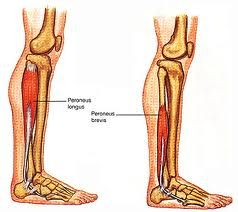
|
A
- evert the foot - assist to plantar flex the ankle N - Superficial peroneal L4, L5, S1 O - distal 2/3 of lateral fibula I - tuberosity of 5th metatarsal |
|
|
Muscles innervated by Cranial Nerve V - Trigeminal
(1413 Ex3) |
- medial pterygoid
- lateral pterygoid - masseter - temporalis |
|
|
|
Muscles innervated by Cranial Nerve VII - Facial
(1413 Ex3) |
- occipitofrontalis
- platysma - buccinator - orbicularis oculi - orbicularis oris - risorius - zygomaticus major |
|
|
|
Diarthrosis joints move
|
freely
|
|
|
|
Muscles innervated by lumbar plexus
(1413 Ex3) |
- quadratus lumborum
- psoas major |
|
|
|
Muscles innervated by phrenic nerve
(1413 Ex3) |
diaphragm
|
|
|
|
Muscles innervated by femoral nerve
(1413 Ex4) |
- iliacus
- sartorius - rectus femoris - vastus medialis - vastus intermedius - vastus lateralis - pectineus (also with obturator) |
|
|
|
Muscles innervated by inferior gluteal nerve
(1413 Ex4) |
gluteus maximus
|
|
|
|
Muscles innervated by superior gluteal nerve
(1413 Ex4) |
- gluteus medius
- gluteus minimus - TFL |
|
|
|
Muscles innervated by sacral plexus
(1413 Ex4) |
- piriformis
- quadratus femoris - obturator internus - gemellus superior - gemellus inferior |
|
|
|
Muscles innervated by sciatic nerve
(1413 Ex4) |
- semitendinosus
- semimembranosus - biceps femoris (long head) - tibial branch - biceps femoris (short head) - peroneal branch - adductor magnus (also with obturator) |
|
|
|
Muscles innervated by deep peroneal nerve
(1413 Ex4) |
- tibialis anterior
- extensor hallucis longus - extensor hallucis brevis - extensor digitorum brevis |
|
|
|
Muscles innervated by peroneal nerve
(1413 Ex4) |
extensor digitorum longus
|
|
|
|
Muscles innervated by superficial peroneal nerve
(1413 Ex4) |
- peroneus longus
- peroneus brevis |
|
|
|
Muscles innervated by obturator nerve
(1413 Ex4) |
- gracilis
- obturator externus - adductor brevis - adductor longus - adductor magnus (also with sciatic) - pectineus ( also with femoral) |
|
|
|
Muscles innervated by tibial nerve
(1413 Ex4) |
- gastrocnemius
- soleus - plantaris - popliteus - tibialis posterior - flexor digitorum longus - flexor hallucis longus - abductor digiti minimi - abductor hallucis - adductor hallucis - flexor hallucis brevis - flexor digitorum brevis - flexor digiti minimi brevis - dorsal interossei - plantar interossei - lumbricals - quadratus plantae |
|
|
|
Anterior cervical triangle borders
|
- mandible
- sternocleidomastoids |
|
|
|
Anterior cervical triangle contents
|
- carotid artery
- jugular vein |
|
|
|
Axillary region borders
|
- pectorals
- serratus anterior - latissimus dorsi |
|
|
|
Axillary region contents
|
- brachial plexus
- brachial/axillary artery - brachial/axillary vein |
|
|
|
Cubital fossa borders
|
- brachioradialis
- pronator teres |
|
|
|
Cubital fossa contents
|
- biceps tendon
- brachial artery - median nerve |
|
|
|
Carpal tunnel borders
|
- flexor retinaculum
- carpals |
|
|
|
Carpal tunnel contents
|
- median nerve
- wrist flexor tendons (FCR, FDS, FDP, FPL) |
|
|
|
Femoral triangle borders
|
- inguinal ligament
- sartorius - adductor longus |
|
|
|
What are the six major types of synovial joints?
|
- ball-and-socket joints
- condyloid joint - gliding joints - hinge joints - pivot joint - saddle joint |
|
|
|
Femoral triangle contents
|
- femoral nerve
- femoral artery - femoral vein |
|
|
|
Describe a gliding joint
|
articulating surfaces are usually flat so one bone slides on the other bone
(e.g., carpal bones; SI joint) |
|
|
|
Popliteal fossa borders
|
- biceps femoris
- semitendinosus - semimembranosus - gasatrocnemius |
|
|
|
Describe a hinge joint
|
spool-like surface of one bone that fits into the concave surface of another
uniaxial (flexion and extension) (e.g., elbow, knee, ankle) |
|
|
|
Popliteal fossa contents
|
- common peroneal (fibular) nerve
- tibial nerve - popliteal artery - popliteal vein |
|
|
|
Describe a pivot joint
|
rounded, pointed surface of one bone articulates within a ring formed partly by bone and partly by ligament
(e.g., between atlas and axis) |
|
|
|
TMJ
- close-packed position - open-packed position |
- clenched teeth
- mouth slightly open |
|
|
|
Describe a saddle joint
|
opposing articular surfaces that look like a saddle
(e.g., carpometacarpal joint of the thumb) |
|
|
|
Shoulder
- close-packed position - open-packed position |
- abduction & external rotation
- slight abduction |
|
|
|
Describe a ball-and-socket joint
|
composed of a globe-like head in one bone that fits into a cup-like concavity of another bone
(e.g., hip joint, shoulder joint) |
|
|
|
Elbow
- close-packed position - open-packed position |
- extension
- flexion & slight supination |
|
|
|
Describe a condyloid (ellipsoidal) joint
|
modification of ball-and-socket joint in which most of the movements are possible (flexion, extension, abduction, adduction), but there is no rotational movement
(e.g., wrist joint) |
|
|
|
Wrist
- close-packed position - open-packed position |
- extension & radial deviation
- neutral & slight ulnar deviation |
|
|
|
Hip
- close-packed position - open-packed position |
- hyperextension & internal rotation
- slight flexion, abduction, and external rotation |
|
|
|
What type joints are in sutures and gomphoses?
|
fibrous synarthrosis
|
|
|
|
Knee
- close-packed position - open-packed position |
- extension
- slight flexion |
|
|
|
Ankle
- close-packed position - open-packed position |
- dorsiflexion
- slight plantar flexion |
|
|
|
An immobile joint is called
|
synarthrosis
|
|
|
|
A movable joint is called
|
diarthrosis
amphiarthrosis has some movement |
|
|
|
Give an example of a cartilaginous joint
|
- symphysis (pubis or intervertebral discs)
- synchondrosis (epiphyseal plates) |
|
|
|
In which joints do you find menisci?
|
- knee
- TMJ - both ends of clavicle (acromio and sterno) |
|
|
|
What is the difference between syndesmosis and symphysis?
|
- syndesmosis is fibrous
- symphysis is cartilaginous |
|
|
|
A joint made of a thin fibrous tissue is a:
a. syndesmosis b. suture c. gomphosis d. dianthrosis |
b. suture
|
|
|
|
The joint between the fibula and tibia is
|
syndesmosis
|
|
|
|
Three examples of fibrous joints
|
- suture (thin)
- syndesmosis (thick) - gomphosis (teeth, peg) |
|
|
|
Two examples of cartilaginous joints
|
- synchondrosis (epiphyseal plate)
- symphysis (intervertebral discs or pubis) |
|
|
|
Example of synovial joint
|
all movable
|
|
|
|
Three examples of synarthrosis
|
NO MOVEMENT
- suture - gomphoses - synchondrosis (epiphyseal plate) |
|
|
|
Two examples of amphiarthrosis
|
SOME MOVEMENT
- symphysis - syndesmosis |
|
|
|
Examples of diarthrosis
|
any typical synovial joint
|
|
|
|
Name the muscles comprising the force couple for anterior pelvic tilt. ***
|
- trunk extensors (erector spinae)
- hip flexors (iliopsoas, rectus femoris, sartorius, TFL) |
|
|
|
Name the muscles comprising the force couple for posterior pelvic tilt. ***
|
- trunk flexors (rectus abdominis)
- hip extensors (gluteus maximus and hamstrings) |
|
|
|
Prime movers for scapular upward rotation ***
(1413 Ex2) |
- serratus anterior
- upper trapezius - lower trapezius (force couple!!) |
|
|
|
Prime movers for scapular downward rotation ***
(1413 Ex2) |
- pectoralis minor
- levator scapula - rhomboids (force couple!!) |
|

